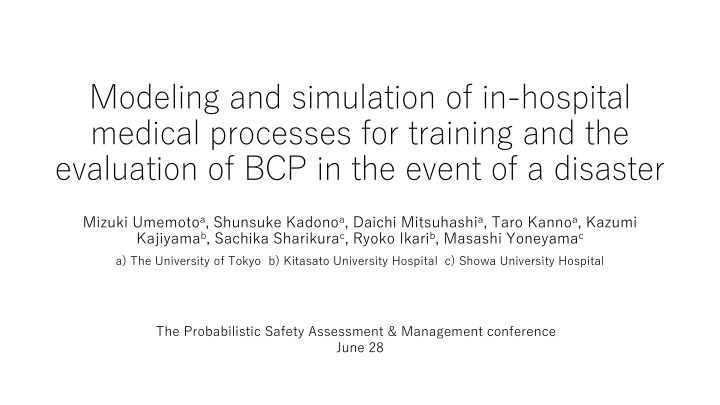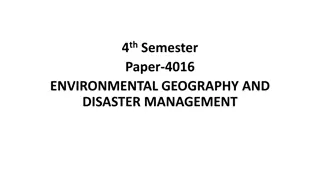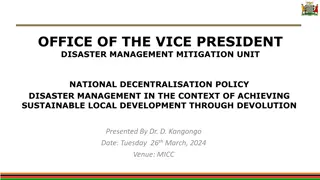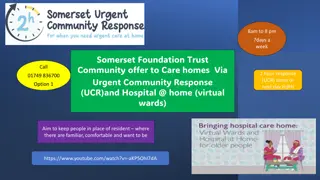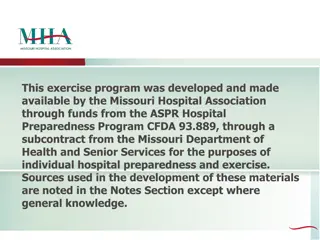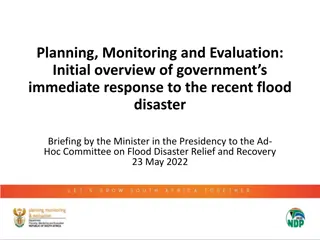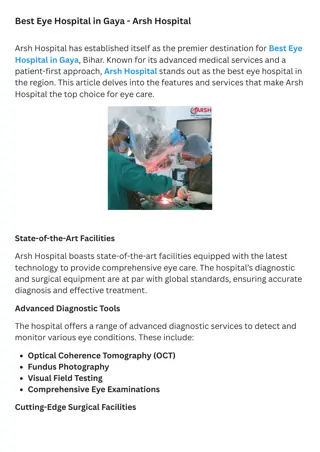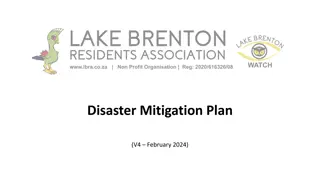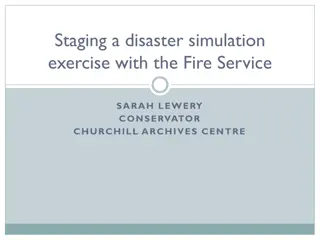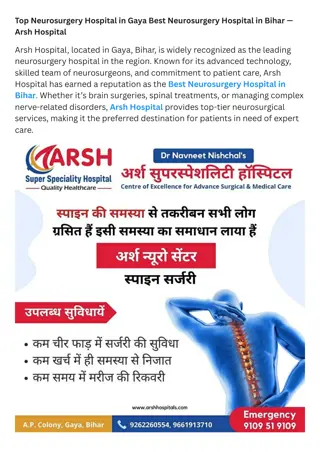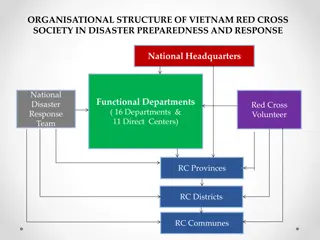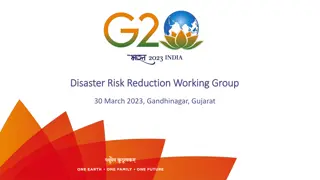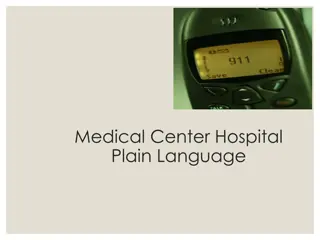Modeling and Simulation of In-Hospital Medical Processes for Disaster Response Evaluation
This research focuses on developing a realistic simulation model to evaluate hospital disaster response performance, identify bottlenecks in business continuity plans, and streamline training processes. By assessing the existing methods and requirements for disaster base hospitals, the study aims to enhance preparedness and efficiency in managing medical processes during emergencies.
Download Presentation

Please find below an Image/Link to download the presentation.
The content on the website is provided AS IS for your information and personal use only. It may not be sold, licensed, or shared on other websites without obtaining consent from the author.If you encounter any issues during the download, it is possible that the publisher has removed the file from their server.
You are allowed to download the files provided on this website for personal or commercial use, subject to the condition that they are used lawfully. All files are the property of their respective owners.
The content on the website is provided AS IS for your information and personal use only. It may not be sold, licensed, or shared on other websites without obtaining consent from the author.
E N D
Presentation Transcript
Modeling and simulation of in-hospital medical processes for training and the evaluation of BCP in the event of a disaster Mizuki Umemotoa, Shunsuke Kadonoa, Daichi Mitsuhashia, Taro Kannoa, Kazumi Kajiyamab, Sachika Sharikurac, Ryoko Ikarib, Masashi Yoneyamac a) The University of Tokyo b) Kitasato University Hospital c) Showa University Hospital The Probabilistic Safety Assessment & Management conference June 28
Table of contents Background and objectives Modeling of the hospital disaster response Simulation of the hospital disaster response Discussion and conclusion 2
Background and objective Requirements for disaster base hospitals[1] Disaster base hospitals play a key role in the event of disasters Disaster base hospitals must meet some requirements Prepare a business continuity plan(BCP) Conduct trainings based on CSCATTT Command and control/Safety/Communication/Assessment/ Triage/Treatment/Transportation [1] Ministry of Health, Labour and Welfare, Partial Revision of Requirements for Designation as a Disaster Base Hospital, 2020, available: 3
Background and objective Current methods to meet the requirements and their limitations Requirements Current methods Limitations A great deal of effort to prepare them Limited participation Difficulty in evaluating the result quantitatively Desktop or live drills [2] Conduct trainings Low variety of resources and processes considered Simple patient model Computer simulations[3][4] Evaluating BCP [2] https://meccso.jp/emergo/about-emergo.html [3] Franc JM, Ingrassia PL, Verde M, et al., A Simple Graphical Method for Quantification of Disaster Management Surge Capacity Using Computer Simulation and Process-control Tools, Prehosp Disaster Med. 30(1):9-15 (2014) [4] A. Basaglia, E. Spacone, J.W. van de Lindt, T.D. Kirsch, A Discrete-Event Simulation model of hospital patient flow following major earthquakes, International Journal of Disaster Risk Reduction, 71 (2022) 4
Background and objective Objectives of this research Develop a highly realistic simulation model of the hospital disaster response 1.Evaluate the response performance 2.Find bottlenecks in the existing BCP 3.Make trainings easier to conduct 5
Modeling of the hospital disaster response Overview Inputs Outputs Simulation Patients scenario Detailed patients information Patients arrival time Disaster medicine processes Results of disaster response Resource scenario Length of stay Number of patients in each room Triage Treatment Examinations Staff arrival scenario Medical resources supply scenario 6
Modeling of the hospital disaster response Patients model Patient model is created in XML format based on the patient data created for training purposes Categories Examples Basic information ID/Name/Age/Sex Vital Signs Conscious level/Blood pressure/Pulse Severity of the patient Triage level/Injury name Processes required Resources and time required Consumable resources (ex : gauze/saline) Unconsumable resources(ex : stretcher/staff) 7
Modeling of the hospital disaster response Patients flow The processes from triage to discharge are modeled 8
Modeling of the hospital disaster response Detailed medical processes Each process is described in an input process output format 9
Simulation of the hospital disaster response Scenario Settings Simulations under 3 different scenario were conducted Patients scenario Higher volume within a shorter period Normal Normal Base scenario Severe Scenario Resource scenario Reallocated among areas Staff reallocating scenario - 10
Simulation of the hospital disaster response Patients scenario Each patient has different conditions and requires different treatment processes and resources Arrival time is set according to an exponential distribution One time step is 10 s f(arrival time step = t) = e- t+ C * Constant C depends on patient triage level 11
Simulation of the hospital disaster response Patients scenario Parameters (Base scenario and Staff reallocating scenario) : 0.005 : 360 : 0.005 : 180 : 0.005 : 0 : 0.005 : 180 Number of patients Parameters (Severe scenario) Triage level Red (severe) Yellow (moderate) Green (minor) Black (dead) 13 : 0.005 : 180 : 0.005 : 90 : 0.005 : 0 : 0.005 : 180 23 41 3 * f(arrival time step = t) = e- t+ C 12
Simulation of the hospital disaster response Resource scenario Number of doctors/nurses /transportation staff (Base scenario and severe scenario) Number of doctors/nurses /transportation staff (Staff reallocating scenario ) Room Triage room 6/6/6 4/4/4 3 consultation room 6/6/6 5/5/5 2 examination room 6/6/6 7/7/7 3 treatment room 6/6/6 7/7/7 13
Simulation of the hospital disaster response Results : Base scenario - Length of stay of each patient There were large amount of waiting time to be reduced Treatment time Waiting time 1800 1600 1600 Length of stay (time step) 1600 1400 Length of stay (time step) 1400 Length of stay (time step) 1400 1200 1200 1200 1000 1000 1000 800 800 800 600 600 600 400 400 400 200 200 200 0 0 377 389 389 411 427 452 496 582 608 687 752 786 957 0 201 234 253 262 274 284 347 382 429 554 713 818 2 11 28 45 117 143 194 234 252 294 390 500 606 730 Arrival time (time step) Arrival time (time step) Arrival time (time step) Green(minor) patients Yellow(moderate) patients Red(severe) patients 14
Simulation of the hospital disaster response Results : Base scenario - Number of patients in XP room Many patients had to wait in the XP room 15
Simulation of the hospital disaster response Results : Difference in base scenario and severe scenario Higher volume of patients within a shorter period caused a delay in response 35 30 Average length of stay Base scenario Number of patients 25 Patients Base scenario 989 Severe scenario 1018 20 Severe scenario 15 All 10 Red 1103 1162 5 Yellow 1139 1162 0 1 201 401 601 801 1001 1201 1401 1601 1801 2001 2201 2401 2601 2801 3001 Green 939 964 Time Step Black 28 29 The number of patients in the XP room 16
Simulation of the hospital disaster response Results : Difference in base scenario and staff reallocating scenario Staff reallocation increased response efficiency 30 Average length of stay 25 Base scenario Staff reallocation scenario 965 Number of patients 20 Patients Base scenario Staff reallocatiog scenario 15 All 989 10 Red 1103 1054 5 Yellow 1139 1070 0 1 201 401 601 801 1001 1201 1401 1601 1801 2001 2201 2401 2601 2801 3001 Time step Green 939 947 Black 28 29 Number of patients in XP room 17
Discussion and conclusion Discussion Objective Findings The response performance could be evaluated by the length of stay and number of patients in each room Severe patient scenarios were identified The extent to which patients can be treated was identified in each scenario Evaluate the response performance Find bottlenecks in the existing BCP Some processes such as XP were found to be bottlenecks Staff reallocation can solve the bottlenecks 18
Discussion and conclusion Conclusion A simulation model for more realistic hospital response during a disaster was developed Simulations under several scenarios were conducted to assess the severity of the situation and the effectiveness of resource reallocation We will extend the model to include other functions and develop a human-in-the-loop simulation for the training purposes 19
